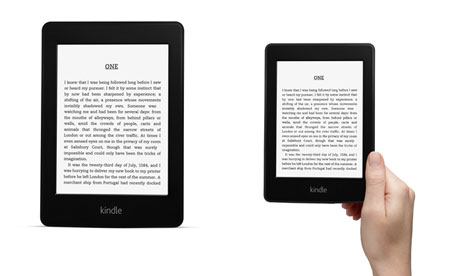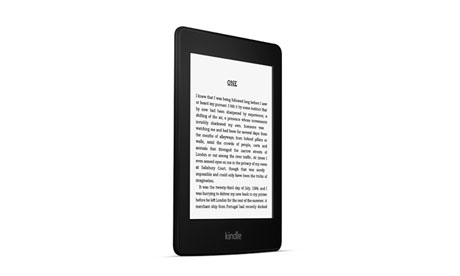If you still prefer real books to electronic gizmos, then Amazon's Kindle Paperwhite – which has just started shipping in the UK – is a good reason to think again.
Where earlier Kindle e-readers had grey screens, the Paperwhite has a white, frontlit, E-Ink screen with greatly increased contrast, so it comes much closer to the ideal of black ink on white paper. There are some shiny tablets that could almost double as mirrors, but there's no way you can see your face in the flat matt screen of a Paperwhite.
The exterior design has also come a long way from the original Kindle with its push-button keyboard. The Paperwhite's body is pleasantly matt and black, with no visible buttons. The only things that break the surface are the tiny on-off button, indicator light, and micro USB port on the bottom edge.
Although some people will hanker after a physical "next page" button, you can move to the next page just by touching the screen. You can still read one-handed while standing on a bus or train. However, you might need two hands when you want to touch or tap a thin strip of screen down the left hand side, which takes you back a page, or along the top, which calls up the menu. (You can reach all three areas if you are left-handed.)
Tablet users will note that you can swipe across the Paperwhite screen to turn pages, but why would you bother when the lightest tap does the job?
The menu icons are easy to understand. From left to right, there's a home button, a back-arrow, a lightbulb for setting the light level, a shopping trolley, a magnifying glass for search, and three horizontal bars (like the ones on Google's Chrome browser) for a set of drop-down menu options. These options change according to what you're doing. When reading a book, for example, they include Add Bookmark, View Notes and Marks, and Reading Progress. One option switches from portrait to landscape mode. This is useful for graphical material, though the image quality is rather poor.
 Amazon's Kindle Paperwhite is light and its backlit screen makes it the most comfortable to use ereader on the market right now. Photograph: Amazon
Amazon's Kindle Paperwhite is light and its backlit screen makes it the most comfortable to use ereader on the market right now. Photograph: Amazon The lightbulb menu provides 24 levels of brightness, to cope with a wide range of lighting conditions from sunlight to complete darkness. The backlighting is unusually even across the screen, except for a thin strip along the bottom. At the maximum setting, the screen is very bright, while the minimum takes you back to the bad old days of black-on-grey ereading.
The Paperwhite is designed to have the light on all the time. Amazon says: "a single charge lasts up to eight weeks, based on half an hour of reading per day with wireless off and the light setting at 10."
One big advantage of e-readers over paper books is that you can change the typeface and font size to suit your preferences. The Paperwhite offers a choice of six typefaces including Baskerville (with serifs) and Helvetica (without). Each comes in seven sizes from roughly 9 1/2 points to about 36 point text, and even the smallest size looks sharp on the 758 x 1024-pixel screen. You can also change the line spacing and margins.
An e-reader can also measure your "reading time". The Paperwhite notes how often you turn pages and gives you an estimated time left in book. With physical books, you can see if you are close to the end, and the Paperwhite provides a substitute by counting down the hours and minutes to go.
The Paperwhite also offers limited parental controls to block access to the somewhat primitive web browser, the Kindle store, and the Cloud where copies of all your books are stored. You can therefore let your kids read books without having to worry about them downloading inappropriate material or ordering tons of stuff from Amazon.
 The Paperwhite has no headphone jack or loudspeaker for listening to audio books or playing background music. Photograph: Amazon
The Paperwhite has no headphone jack or loudspeaker for listening to audio books or playing background music. Photograph: Amazon But while Amazon has improved the Paperwhite's core functionality, some things have been lost. There's no headphone jack or loudspeaker for listening to audio books or playing background music, which you could do with a tablet. Also, the Paperwhite has only 1.25GB of free memory (out of the 2GB total). Amazon reckons this "holds up to 1,100 books", but it doesn't leave much room for your own PDF files, Microsoft Word documents, unprotected books etc, which you can load onto the Kindle by emailing them to a special Amazon address.
The space problem could be solved if the Paperwhite had an SD memory card slot, but it doesn't. Of course, your books and emailed documents are stored "in the cloud" so you can redownload them via Wi-Fi (802.11b/g/n) just by touching them. But if you are often out of Wi-Fi range on beaches, trains, boats and planes, consider stumping up an extra £60 for the 3G version with Amazon's free Whispernet access.
So, all round, the Kindle Paperwhite looks like the best e-reader on the market. The problem is, the market is changing. There's a big gulf between a £69 Kindle and a £250 laptop or a £400 tablet, but not between a £109 Paperwhite and a £129 Kindle Fire tablet (with "special offers"; ie ads), or even a Google Nexus 7 (from £170). Indeed, the 3G version of the Paperwhite (£169) costs £10 more than the Kindle Fire HD (£159).
I put the Paperwhite next to my Nexus 7 running Amazon's free Kindle app and there's not that much in it. The Nexus 7 is pretty good for reading novels, and considerably better for reading newspapers and magazines, browsing the web, listening to music, watching movies, playing games and so on. Of course, the Nexus 7 is a lot heavier and it has a much shorter battery life, but it does a lot more.
I've not had a chance to try a Kindle Fire, which is Amazon's entry-level tablet, but its Kindle app does much the same job as the Paperwhite. It's a bit bulkier and almost twice as heavy (400g v 213g), but it has more storage (16GB v 2GB), a bigger colour screen (7in v 6in), and multimedia features the Paperwhite lacks. You can see why Amazon now feels the need to offer both.
Pros: Light weight and long battery life make the Paperwhite almost perfect for reading novels and other long-form literature on the move, and its illuminated screen means you can read comfortably in bed. Books download quickly. It looks good and feels well made.
Cons: No colour, no sound, limited storage and no expansion facilities. Only £20 cheaper than a Kindle Fire tablet.

Thanks for this great share. This site is a fantastic resource I hope you will share again another useful technical post for online users.
ResponderEliminarKindle Frozen Screen